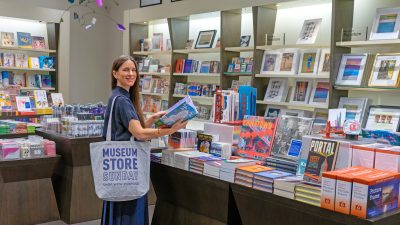This article originally appeared in the March/April 2009 issue of Museum magazine, a benefit of AAM membership.
Ten-year-old Alejandra, playing the part of a fortunate daughter of Virginia patriot George Mason, has spilled a slice of onion pie on her raspberry silk dress. In 1770, you can’t just send your soiled duds off to the dry cleaner. But there are slaves for such things and they whisk her fine dress off to the laundry. Once there, they spread it across a white-covered table next to a crackling wood fire and begin scrubbing the stain with bran.
“Bran? Like Raisin Bran?” asks 10-year-old Alyiah, incredulously.
Indeed, the common cereal was a Colonial stain remover. Question answered, Alyiah takes another handful of the pale grain and works it into the fabric. She smiles widely, though, because this kid is no slave from history. Rather, she’s a student of it. And this is one of the most interesting lessons yet.
Skip over related stories to continue reading articleBoth Alejandra and Alyiah are fourth-graders from Mosby Woods Elementary in suburban Fairfax County, Va. This morning, their school bus sailed down the grand alley of Gunston Hall, Mason’s landmark plantation overlooking the Potomac River, with a singular purpose: a field trip. This is where the curriculum comes alive, says their teacher, Melissa Cox.
For teachers across the country, museum field trips are essential tools in creating vibrant, memorable lessons. But as school budgets tighten and educators face increasing pressure to tailor their lessons to standardized tests, that kind of hands-on, real-life educational experience may be endangered. Sort of like trans-Atlantic travel on the RMS Queen Mary—it sounds lovely, of course. But do we really have the time? Or the money? The answer is yes. Field trips shouldn’t be considered luxury travel. But educators from California to Connecticut say the future of these learning adventures really depends on whether a museum experience can offer the kind of focused educational experience they need.
“It can’t just be fun. And it has to go beyond an emotional connection,” says Tracey Wilson, a U.S. history teacher in West Hartford, Conn., who won that state’s History Teacher of the Year award in 2008. For more than 20 years, Wilson has been taking her students on purposeful trips to the nearby Noah Webster House as well as to Old Sturbridge Village, an outdoor history museum in Massachusetts. It is fun, sure. But it’s not just for fun.
No Child Left Behind (NCLB), the controversial 2001 federal law, aims to have every student in the country—no exceptions—passing state standardized tests in reading and math by 2014. It’s a noble goal, especially as it has focused new attention on the lagging scores of black and Hispanic students. But with such an ambitious benchmark, you may as well call it Every Child on His Behind. With schools under tremendous pressure to improve scores in those core subjects, many school administrators have called for increased “seat time,” which sounds exactly like what it is. There’s your desk—sit down, listen and learn. And it often doesn’t include art, music or physical education classes. A chief complaint about NCLB from parents and teachers is that its laser-like focus on reading, math and now science test scores has forced a narrowing of the curriculum.
At one Palm Beach County, Fla., elementary school, too many students—many still learning English—failed to pass that state’s reading test; the principal’s first response was to end recess and field trips. “Florida Comprehensive Assessment Test, yes. Field trips, no,” says Alexandra Navarro Clifton, a Palm Beach County parent and high school English teacher.
Meanwhile, school districts are also coping with the worst economy in most school board members’ memories. In Virginia’s Fairfax County, those Mosby Woods kids visiting Gunston Hall are lucky. Under a proposed budget to solve that district’s $220 million shortfall, next year’s fifth-graders would have to stay in the classroom. No trips would be allowed. Several hundred miles north, in an effort to cut field trip costs, one western Massachusetts principal has decided to drive the bus himself.
So, take a pinch of NCLB mania, add a heaping spoonful of budget woes, and you’ve got a recipe for field trip poison. But it doesn’t have to be fatal. Many teachers still believe that field trips are an irreplaceable learning tool—a way to make their classroom lessons come alive and to create lifelong memories (and lessons) for their students. They will make the case for field trips to their principals and other school administrators, but they need your help.
Since NCLB and its demands are a fact of life, educators must reshape field trips so they support a standards-based curriculum. (Although changes to NCLB by Congress are likely this year, most policy-watchers don’t expect a total reversal in policy. It’s more likely that states will have a greater role in deciding how to measure proficiency and greater latitude in deciding how to test English Language Learners or kids with disabilities.) With that in mind, teachers can’t just go to Gunston Hall to have a little break from the routine and kick-start their kids’ imaginations about life in Colonial times. But they can certainly go there because Virginia’s Standards of Learning test requires fourth-graders to learn about George Mason and the document he authored, the Virginia Declaration of Rights (an influential progenitor to the U.S. Bill of Rights). “This is right out of the standards,” Cox says as she surveys her students splitting into small groups for different learning centers. Students shifting uncomfortably within the faint boundaries of incredibly small slave quarters are learning “VS.4.a,” or the “importance of agriculture and its influence on the institution of slavery.”
“How many 10-year-olds do I have?” a Gunston Hall docent asks the group. As hands go up, he nods at his new slaves. “Great. I have a lot of field workers. And I’ll be waking you up at 4 a.m.”
Inside an outbuilding on the Gunston Hall estate, the Mosby Woods kids dip white goose feather quills into shallow plates of black ink and take a stab at old-fashioned penmanship. Their task is copying this sentence: “All men are by nature equally free and independent and have certain inherent rights.” Dry quills scratch paper—and also etch a memorable lesson into a 10-year-old’s mind.
“If I were a museum professional,” says California science teacher Anthony Cody, “I’d look at the content standards for the grades that I was trying to attract, and I’d figure out what aspects and exhibits in my facility could help with those particular standards.” He suggests, “I’d also think about activities the teachers could do in their classrooms before they came to the museum.”
Ambitious? Maybe, but remember that the field trip isn’t a stand-alone event for most teachers. When they embark on a unit of study, something like “Early Explorers” or “Animal Habitats,” teachers often spend weeks or months in that area, and they’ll use all sorts of teaching tools: songs, worksheets, guest speakers, computer games, group projects, posters and, of course, field trips.
Pre-trip materials provided by a museum destination can do two things: serve as another tool to teach the standards and prepare kids for what they’re going to see on their excursion. With the right preparation, they should be ready to open their minds as soon as the school bus doors open. When Cody taught animal adaptations to his Oakland middle-school students, their trip to the California Academy of Sciences was just one part of a month’s worth of lessons. First they learned about false eyespots and body coloration in the classroom; then they saw it in the aquarium tanks. Any information that the museum could have provided ahead of time about its exhibits would have been helpful, he said.
For Donnalyn Schuster, an upstate New York high school art teacher, online access to a museum’s collection is the best preparation. “Some museums have slide kits—it’s old technology, but it works. A nice online gallery with information about the particular artist is even more helpful. We try to give students some background information before they go.”
Even better, teachers can sometimes find a way for students to relate to the people they’re learning about. Christine Southard, a second-grade teacher from Long Island, N.Y., recently shared with students a letter that could have been written by a 10-year-old farm girl whose parents moved from Long Island to Illinois in 1839. “My Father has been worried because the drought has been bad for the last couple of years,” Jennifer Smith wrote, explaining how it was getting harder and harder to scratch out a living. So the Smiths decided to take their chances somewhere else, the letter reads. First they’ll take a stagecoach to Chicago, then a new railroad car to St. Joseph’s, Mo., and then they’ll pack a wagon for the 2,000-mile journey along the Oregon Trail.
“I can’t wait to meet you so that you can help us choose the best kind of wagon to buy for our trip,” Jennifer wrote. “Maybe you will think of things we should include on our long journey that we have forgotten. See you at 10 a.m.” At the Long Island Museum, that is, where the kids will climb aboard that iron-horse train, just like their pen pal. “Their knees were bumping, just piled in there together, back to back, seated on top of each other, holding tickets. ‘Son! You don’t have a ticket! You’ll have to get out of the train!’” Southard recounts. “It was a great role-playing exercise.”
Here’s one piece of advice: Forget the scavenger hunt. “When kids get into a new environment, if they don’t have something concrete to do, they tend to run around. Scavenger hunts … tend to be trivial pursuits,” says Cody. What many teachers prefer, especially elementary- and secondary-school history teachers, are role-playing exercises because they engage students on a deeper level and aid their mastery of the curriculum standards. Role-playing helps students make emotional connections, says Connecticut history teacher Wilson, and also to process questions and find answers.
Susan Hildt, a fifth-grade teacher at the Renbrook School in Avon, Conn., organizes a year’s worth of American history around an enormous role-playing event, when each of her students assumes the role of a Colonial tradesperson—cooper, blacksmith, apothecarist—right down to the appropriate Old English accent. To help them develop their roles, they visit Old Sturbridge Village and seminal sites in Boston, including the Granary Burying Ground and Old South Church. At the latter, they’ll actually hold a town meeting.
“Fie, fie, fie! Yea! Yea!” the kids shout, as they divide into Patriots and Loyalists and debate the king’s prerogative to tax their tea.
Wilson takes role-playing to a more sophisticated level for her high school students, using primary source documents. At Noah Webster House, where Wilson also serves as historian, she has designed activities for visiting students, including her own. In one, they explore what life would have been like in 1775. And it’s not enough just to wear the shackles—they also need to use historical documents to help them learn their roles. “If high school students can really give it up and get into the game, really suspend their identities and become somebody else … well, that’s the beauty of being [at] a historic place. You have the place, as well as the program, to bring them back in time,” Wilson says. “But you have to go beyond the emotions. They have to go into it with a question in mind.”
But finding the answers, either through role-play or other activities, doesn’t mean the lessons are over. Just as teachers engage in pre-trip activities, they also use the experience in post-trip lessons. Wilson’s Advanced Placement U.S. history students returned from Old Sturbridge Village with a specific assignment: writing a series of letters between a farmer who lives in Sturbridge, a rural community of the 1830s, and a friend who moved to Ohio or South Carolina. The letters should reveal the effects of the market revolution on their lives. “Their job, while we’re at Sturbridge, is to go around, talk to interpreters and record the information that they’ll need,” Wilson says. Meanwhile, Southard’s students are working on their own post-trip activity: turning all of the audio, video and still photographs they shot during their trip to the Long Island Museum into multimedia projects.
Back at Gunston Hall, 10-year-old Adam says sitting on a wooden bench in a cold schoolhouse, genuine white quill in his fist, was his favorite part of the trip. Others were fascinated by the full-skirted Colonial cooks with hot waffle irons in hand. And, of course, all of the Mosby Woods kids enjoyed games in the garden, pushing a teetering hoop with a wooden stick or painstakingly tossing a wooden ball into a small cup. “I am determined to get this in there!” says Bonnie, swinging her arms and bending her knees in a full-body effort to beat the 300-year-old game.
But during docent lectures, especially outside on a blustery 32-degree morning, their attention wanes. “Can we go back to the bus?” whispers one. And the Touch Museum, where they sat for a lecture on the Boston Tea Party—a subject they haven’t covered yet in class—was disappointing. “I might have thought we would actually get to touch things,” Cox notes.
Hands-on activities are the Lost Ark of field trips. Everybody is looking for them. When first-grade teacher Amber Sterns recounts her very best field trip to the Minnesota Children’s Museum, she immediately says, “It was so hands-on!” Her kids threw on “community helper” costumes and pretended to be chefs, police officers, nurses and grocery store clerks. “The kids loved that part. And me, too! They wrote about that experience in their journals for a long time afterward.”
Sterns teaches kids who are still learning English, a rapidly growing group in the United States, particularly in heartland states like Nebraska and Colorado and much of the Southeast. They may be immigrants, but more likely they were born in the United States to immigrant parents. Currently, about 10 percent of American students are classified as “limited English proficient.” And about 14 percent of all students have been identified as disabled, about half of whom have “specific learning disabilities” (a federal classification defined by law as “an imperfect ability to listen, think, speak, read, write, spell, or to do mathematical calculations”). Basically, they don’t learn the same way as other kids. Nonetheless, the vast majority of these students will be included in mainstream classrooms like Long Island teacher Christine Southard’s. She is a special education teacher who works in a regular classroom with a co-teacher.
What this means for museum professionals is that not every child can—or should—listen quietly to a lecture on the Boston Tea Party. Some, called “auditory learners” by educational researchers, will do just fine in a “listen carefully, children” environment, but educators believe those students are few—possibly as little as 10 percent of the school population. More students (particularly girls, researchers say) are “visual learners” who learn best by seeing or reading. The rest are tactile or kinesthetic learners, and they’re the ones who start smiling in a museum’s discovery room. They learn best by touching, feeling and experiencing. With these differences in mind, the museum experience needs to be multisensory to reach every child, says Southard. “How are you going to meet these different kinds of learners?”
Academics aside, teachers have a few other requests. First is a place to eat lunch. On their recent trip, Southard and her kids unpacked their PB&J’s on the bus. “You’re really not supposed to eat on the bus,” she sighed, but the lovely courtyard at the Long Island Museum was no place for a picnic in 27-degree weather.
It also would be nice to have a meeting place. And it’s just downright essential to have handy bathrooms, especially for the youngest kids.
What if classes just decided to stay at school? Could you come see them instead? Staffers from Plimoth Plantation, for instance, come to Connecticut’s Renbrook School with costumes for the kids to wear and hands-on demonstrations in toothpaste making. “We’ve completely tailored that in-house trip to our needs,” says teacher Susan Hildt.
And that’s what it’s all about. With time at a premium, test-makers breathing down their necks, parents worried about terrorism and bean-counters crying about the economy, it’s not always easy for teachers to take a field trip.
But it does meet a need: to excite and educate students about the world outside of their classroom doors. As the Mosby Woods kids descend the grand staircase in Gunston Hall, shocked by the lack of bathrooms, entranced by the thought of candlelight and story-telling and educated by the careful preservation of a Colonial family’s home, 10-year-old Alyiah turns and says, “I am having the best time ever!”
Mary Ellen Flannery is a Washington, D.C.-based writer.








Comments